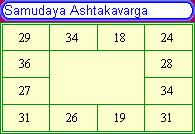Ch. 3. Planet Characters and Description
1. Maitreya: O Mahārśi, you have affectionately explained about the incarnations of Planets. Now kindly tell me in detail their characters and dispositions. 2-3. Parāśara: O Brahmin, listen to the account of placement of the heavenly bodies. Out of the many luminous bodies sighted in the skies some are stars, yet some are Planets. Those, that have no movements, are the Nakshatras (asterisms).
4-6. Those are called Planets, which move through the Nakshatras (or stellar mansions) in the zodiac. The said zodiac comprises of 27 Nakshatras commencing from Ashvini. The same area is divided in 12 parts equal to 12 Rāśis commencing from Aries. The names of the Planets commence from Sun. The Rāśi rising is known, as Lagna. Based on Lagna and the Planets, joining and departing from each other, the natives good and bad effects are deducted.
Addition from Santhanam till Sloka 7. The names of the 27 Nakshatras are Ashvini, Bharani, Krittika, Rohini, Mrigasira, Ardra, Punarvasu, Pushya, Aslesha, Magha, Purvaphalguni, Uttaraphalguni, Hasta, Chitra, Swati, Vishaka, Anuradha, Jyeshtha, Mula, Purvashadh, Uttarashadh, Shravana, Dhanistha, Satabhisha, Purvabhadra, Uttarabhadra, Revati.
Lagna is a very important point in the horoscope. It is the Rāśi that rises in the East, on the latitude of birth. The apparent rising of a Rāśi is due to the rotation of the earth on its own axis at a rate of motion, causing every degree of the zodiac seemingly ascend on the eastern horizon. Approximately two hours are required for a Rāśi to pass via the horizon, thereby every degree taking four minutes to ascend. This duration, however, is actually dependent on the concerned latitude.
Actually Sun has no motion. His motion is an apparent one, as viewed from the rotating earth. Other Planets, including the nodes, have v6thed rates of motion. The average daily motions of the Planets, which are not, however standard, are, as follows: Sun 1, Moon 13-15, Mars30-45, Mercury 65-100, Venus 62-82, Jupiter 5-15, Saturn 2, Rahu/Ketu 3.
With such different motions, a Planet forms various Aspects with others. These Aspects through longitudinal distances have a great deal of utility in Jyotishya. This is what Mahārśi Parashara suggests to be considered.
7. Details (of astronomical nature) of stars have to be understood by general rules, while I narrate to you about the effects of Planets and Rāśis.
8-9. The positions of the Planets for a given time be taken, as per Drikganit. And with the help of Rāśi durations, applicable to the respective places, Lagna at birth should be known. Now, I tell you about the castes, descriptions and dispositions of the Planets.
10. Names of Planets. The names of the nine Planets, respectively, are Sun, Moon, Mars, Mercury, Jupiter, Venus, Saturn, Rahu and Ketu.
11. Benefics and Malefics. Among these, Sun, Saturn, Mars, decreasing Moon, Rahu and Ketu (the ascending and the descending nodes of Moon) are malefics, while the rest are benefics. Mercury, however, is a malefic, if he joins a malefic.
Addition from Santhanam till Sloka 12-13. When Moon is ahead of Sun, but within 120, she has medium strength. Between 120 to 240 she is very auspicious,( see Atishubhapred). From 240 to 0 she is bereft of strength. This is Yavana’s view; vide P. 70 of my English Translation of Saravali. This view is, however, related to Moon’s strength, or otherwise, while the waning Moon (Krishna Paksha, dark half) is a malefic and waxing Moon (Shukla Paksha, bright half) is a benefic. Should Moon be conjunct with a benefic, or receiving a Aspect from a benefic, she turns a benefic, even if in a waning state. As regards Mercury, we have clear instructions from Mahārśi Parashara, that he becomes a malefic, if he joins a malefic. If waning Moon and Mercury are together, both are benefics.
12-13. Planet governances. Sun is the soul of all. Moon is the mind. Mars is ones strength. Mercury is speech-giver, while Jupiter confers Knowledge and happiness. Venus governs semen (potency), while Saturn denotes grief.
14-15. Planet cabinet. Of royal status are Sun and Moon, while Mars is the Army chief. Prince-apparent is Mercury. The ministerial Planets are Jupiter and Venus. Saturn is a servant. Rahu and Ketu form the Planet Army.
16-17. Complexions of Planets. Sun is blood-red. Moon is tawny. Mars, who is not very tall is blood-red, while Mercury’s hue is akin to that of green grass. Tawny, v6thegated and dark are Jupiter, Venus and Saturn in their order.
18. Deities of Planets. Fire (Agni) (?), Water (Varuna), Subrahmanya (Lord Shiva’s son, following Ganesha), Maha Vishnu, Indra, Shachi Devi (the consort of Lord Indra) and Brahma (?) are the presiding deities of the 7 Planets in their order.
19. Gender of the Planets. Mercury and Saturn are neuters. Moon and Venus are females, while Sun, Mars and Jupiter are males.
20. Primordial compounds. Jupiter, Saturn, Mars, Venus and Mercury, respectively govern the Panchabhutas, space, air, fire, water and earth.
21. Castes of Planets. Jupiter and Venus are Brahmins. Sun is a royal Planet, while Moon and Mercury belong to commercial community. Saturn rules the Sudras (4th caste).
22. Nature of Planets. Sattvic Planets are the lumin6thes (Sun & Moon) and Jupiter, Venus and Mercury are Rajasik, while Mars and Saturn are Tamasic.
23. Description of Sun. Sun’s eyes are honey-colored. He has a square body. He is of clean habits, bilious, intelligent and has limited hair (on his head).
24. Description of Moon. Moon is very windy and phlegmatic. She is learned and has a round body. She has auspicious looks and sweet speech, is fickle-minded and very lustful.
25. Description of Mars. Mars has blood-red eyes, is fickle-minded, liberal, bilious, given to anger and has thin waist and thin physique.
26. Description of Mercury. Mercury is endowed with an attractive physique and the capacity to use words with many meanings. He is fond of jokes. He has a mix of all the three humors.
27. Description of Jupiter. Jupiter has a big body, tawny hair and tawny eyes, is phlegmatic, intelligent and learned in Shastras.
28. Description of Venus. Venus is charming, has a splendorous physique, is excellent or great in disposition, has charming eyes, is a poet, is phlegmatic and windy and has curly hair.
29. Description of Saturn. Saturn has an emaciated and long physique, has tawny eyes, is windy in temperament, has big teeth, is indolent and lame and has coarse hair.
30. Description of Rahu and Ketu. Rahu has smoky appearance with a blue mix physique. He resides in forests and is horrible. He is windy in temperament and is intelligent. Ketu is akin to Rahu.
31. Primary ingredients (or Sapta Dhatus). Bones, blood, marrow, skin, fat, semen and muscles are respectively denoted by the Planets: Sun, Moon, Mars, Mercury, Jupiter, Venus and Saturn.
32. Abodes of the Planets. Temple, watery place, place of fire, sport-ground, treasure-house, bed-room and filthy ground: these are, respectively, the abodes for the seven Planets from Sun onward.
33. Planet periods. Ayan, Muhurta, a day (consisting day and night), Ritu, month, fortnight and year: these are the periods allotted to the Planets from Sun to Saturn.
34. Tastes of the Planets. Pungent, saline, bitter, mixed, sweet, acidulous and astringent are, respectively, tastes lorded by Sun, Moon, Mars, Mercury, Jupiter, Venus and Saturn.
35-38. Strengths of Planets. Strong in the East are Mercury and Jupiter. Sun and Mars are so in the South, while Saturn is the only Planet, that derives strength in the West. Moon and Venus are endowed with vigor, when in the North. Again, strong during night are Moon, Mars and Saturn, while Mercury is strong during day and night. The rest (i.e. Jupiter, Sun and Venus) are strong only in daytime. During the dark half malefics are strong. Benefics acquire strength in the bright half of the month. Malefics and benefics are, respectively, strong in Dakshinayan and Uttarayan. The Lords of the year, month, day and Hora (hour of Planet) are stronger than the other in ascending order. Again, stronger than the other in the ascending are Saturn, Mars, Mercury, Jupiter, Venus, Moon and Sun.
39-40. Related to trees. Sun rules strong trees (i.e. trees with stout trunks), Saturn useless trees, Moon milky trees (and rubber yielding plants), Mars bitter ones (like lemon plants), Venus floral plants, Jupiter fruitful ones and Mercury fruitless ones.
41-44. Other matters. Rahu rules the outcaste, while Ketu governs mixed caste. Saturn and the nodes indicate ant-hills. Rahu denotes multi-coloured clothes and Ketu rags. Lead and blue gem belong to Rahu and Ketu. Sun, Moon, Mars, Mercury, Jupiter, Venus and Saturn in their order govern red silken, white silken, red, black silken, saffron, silken and multi-coloured robes.
45-46. Seasons of Planets. Vasanta, Greeshma, Varsh, Sarad, Hemanta and Sisir are the six Ritus (or seasons), respectively, governed by Venus, Mars, Moon, Mercury, Jupiter and Saturn. Rahu and Ketu denote 8 months and 3 months, respectively.
47. Dhatu, Mool and Jiva Divisions. Dhatu Planets are Rahu, Mars, Saturn and Moon, while Sun and Venus are Mula Planets. Mercury, Jupiter and Ketu rule Jivas.
48. Age. Out of all the Planets Saturn is the eldest. He bestows maximum number of years in Naisargik Dasha.
49-50. Exaltation and Debilitation. For the seven Planets, from Sun on, the exaltation Rāśis are, respectively, Aries, Taurus, Capricorn, Virgo, Cancer, Pisces and Libra. The deepest exaltation degrees are, respectively, 10, 3, 28, 15, 5, 27 and 20 in those Rāśis. And in the seventh Rāśi from the said exaltation Rāśi each Planet has its own debilitation. The same degrees of deep exaltation apply to deep fall.
51-54. Additional Dignities. In Leo the first 20 degrees are Sun’s Moolatrikona, while the rest is his own House. After the first 3 degrees of exaltation portion in Taurus, for Moon, the rest is her Moolatrikona. Marsh as the first 12 degrees in Aries, as Moolatrikona with the rest therein becoming simply his own House. For Mercury, in Virgo the first 15 degrees are exaltation zone, the next 5 degrees Moolatrikona and the last 10 degrees are own House. The first one third of Sagittarius is the Moolatrikona of Jupiter, while the remaining part thereof is his own House. Venus divides Libra into two halves keeping the first, as Moolatrikona and the second, as own House. Saturn’s arrangements are same in Aquarius, as Sun has in Leo.
55. Natural Relationships. Note the Rāśis, which are the 2nd, 4th, 5th, 8th, 9th and 12th from the Moolatrikona of a Planet. The Planets ruling such Rāśis are its friends, apart from the Lord of its exaltation Rāśi. Lords other than these are its enemies. If a Planet becomes its friend as well, as its enemy (on account of the said two computations), then it is neutral, or equal.
56. Temporary Relationships. The Planet, posited in the 2nd, 3rd, 4th, 10th, 11th, or the 12th from another, becomes a mutual friend. There is enmity otherwise. (This applies to a given Janm Kundali)
57-58. Compound Relationship. Should two Planets be naturally and tempor6thly friendly, they become extremely friendly. Friendship on one count and neutrality on another count make them friendly. Enmity on one count combined with affinity on the other turns into equality. Enmity and neutral-ship cause only enmity. Should there be enmity in both manners, extreme enmity is obtained. The astrologer should consider these and declare horoscope effects accordingly.
59-60. Ratio of Effects. A Planet in exaltation gives fully good effects, while in Moolatrikona it is bereft of its auspicious effects by one fourth. It is half beneficial in its own House. Its beneficence is one fourth in a friendly Rāśi. In an equals Rāśi one eighth of auspicious disposition is useful. The good effects are nil in debilitation, or enemy’s camp. Inauspicious effects are quite reverse with reference to what is stated.
61-64. Non-luminous Upa Grahas (Sub-Planets). Add 4 Rāśis 13 degrees and 20 minutes of arc to Sun’s longitude at a given moment to get the exact position of the all inauspicious Dhoom. Reduce Dhoom from 12 Rāśis to arrive at Vyatipat. Vyatipat is also inauspicious. Add six Rāśis to Vyatipat to know the position of Prithvesh. He is extremely inauspicious. Deduct P6thvesh from 12 Rāśis to arrive at the position of Chap (Indra 2ndus), who is also inauspicious. Add 16 degrees 40 minutes to Chap, which will give Ketu (UpaKetu), who is a malefic. By adding a Rāśi to UpaKetu, you get the original longitude of Sun. These are the Planets, devoid of splendor, which are malefics by nature and cause affliction.
65. Effects of Sub-Planets. If one of these afflicts Sun, the natives dynasty will decline, while Moon and Lagna, respectively, associated with one of these, will destroy the longevity and wisdom. So declared Lord Brahma, the Lotus-Born.
66-69. Calculations of Gulika etc. The portions of Sun etc. up to Saturn denote the periods of Gulika and others. Divide the day duration (of any week day) into eight equal parts. The eighth portion is Lord-less. The seven portions are distributed to the seven Planets commencing from the Lord of the week day. Whichever portion is ruled by Saturn, will be the portion of Gulika. Similarly make the night duration into eight equal parts and distribute these, commencing from the Lord of the 5th (by) week. Here again, the eighth portion is Lord-less, while Saturn’s portion is Gulika. Sun’s portion is Kaal, Mars’s portion is Mrityu, Jupiter’s portion is Yamaghantak and Mercury’s portion is Ardhaprahar. These durations differently apply to different places (commensurate with v6thable day and night durations).
70. Gulika’s Position. The degree, ascending at the time of start of Gulika’s portion (as above), will be the longitude of Gulika at a given place. Based on this longitude only, Gulika’s effects for a particular nativity be estimated.
71-74. Calculation of Pranapad. Convert the given time into Vighatis and divide the same by 15. The resultant Rāśi, degrees etc. be added to Sun, if he is in a Movable Rāśi, which will yield Pranapad. If Sun is in a Fixed Rāśi, add 240 degrees additionally and, if in a Dual Rāśi, add 120 degrees in furtherance to get Pranapad. The birth will be auspicious, if Pranapad falls in the 2nd, 5th, 9th, 4th, 10th, or 11th from the natal Lagna. In other Houses Pranapad indicates an inauspicious birth.
Notes by Santanam. Ardhaprahar, Yamaghantak, Mrityu, Kaal and Gulika are the 5 Kaal Velas, suggested by Mahārśi Parashara. The day duration, according to altitude, is divided into eight equal parts. The eighth portion is unlorded. The first portion is allotted to the weekday Lord. Other portions follow in the order of weekday Lords. We consider 5 portions of Planets, ignoring that of Moon and Venus. The portions of Sun, Mars, Mercury, Jupiter and Saturn are, respectively, called Kaal, Mrityu, Ardhaprahar, Yamaghantak and Gulika.
In the case of night the durations, or 1/8th parts are allotted in a different order. The first portion goes to the Planet, ruling the 5th weekday Lord, counted from the day in question. The others follow in the usual order. Here again, the 8th part is Lord-less. The portions of Planets from Kaal to Gulika are the same in nomenclature in the night also.
Jatakalankaram gives Rāśis of dignities for these UpaPlanets and Gulika etc.: Exaltation, Debilitation, Swakshetra (own Rāśi)) Dhoom: Leo, Aquarius, Capricorn; Vyatipat: Scorpio, Taurus, Gemini; Parivesh: Gemini, Sagittarius, Sagittarius; Indrachap: Sagittarius, Gemini, Cancer; UpaKetu: Aquarius, Leo, Cancer; Gulika: Aquarius; Yamaghantak: – Sagittarius; Ardhaprahar: – Gemini; Kaal: – Capricorn; Mrityu: Scorpio. From Sun to Saturn no one is exalted in the above-mentioned exaltation Rāśis, nor debilitated in the above-mentioned debilitation Rāśis. Out of the 5 Kaal Velas, viz. Gulika etc., four except Kaal (related to Sun) have their own Rāśi system in the respective Rāśis, ruled by their fathers. Gulika, son of Saturn, has Aquarius, as his own House. Jupiter’s son, Yamaghantak, has it in Sagittarius. Ardhaprahar, Mercury’s son, is in own Rāśi, if in Gemini. Mrityu, son of Mars, has Scorpio, as own House. It is not known, why Kaal, a son of Sun shifted to Capricorn, a Rāśi of his brother (Saturn), leaving his fathers Leo. Obviously, Saturn has given his Moolatrikona to his son Gulika, while he gave Capricorn (a secondary Rāśi) to his brother Kaal.
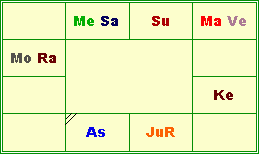
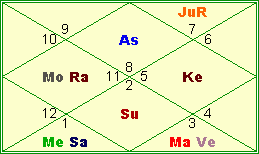
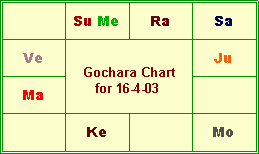
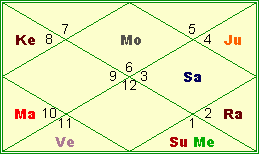
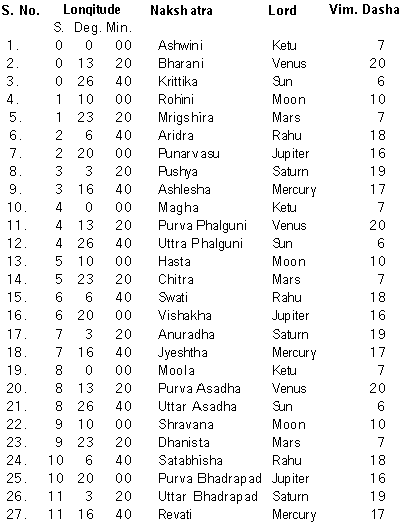
 As the Vimshottari dasa follows a 120 year cycle one will not experience the mahadasa of all the planets in ones life. Depending on by how many degrees, moon has traveled in the nakshatra at the time of birth, the first dasa gets reduced proportionately. In every mahadasa of a planet there are sub divisional dasas of other planets called Antardasas. The first antardasa is that of the mahadasa planet, followed by the other planets in sequence. Following the same principle, the antardasas are further sub divided into Pratyantardasas and so on till we can arrive at the dasas at a daily basis or even hourly basis. The chart of the dasas of the example horoscope, given here to the left illustrates this.
As the Vimshottari dasa follows a 120 year cycle one will not experience the mahadasa of all the planets in ones life. Depending on by how many degrees, moon has traveled in the nakshatra at the time of birth, the first dasa gets reduced proportionately. In every mahadasa of a planet there are sub divisional dasas of other planets called Antardasas. The first antardasa is that of the mahadasa planet, followed by the other planets in sequence. Following the same principle, the antardasas are further sub divided into Pratyantardasas and so on till we can arrive at the dasas at a daily basis or even hourly basis. The chart of the dasas of the example horoscope, given here to the left illustrates this.
